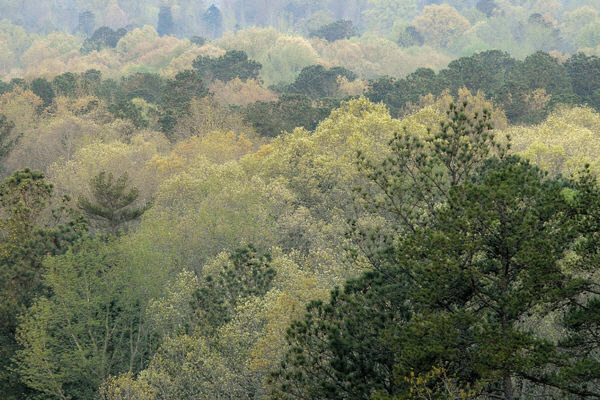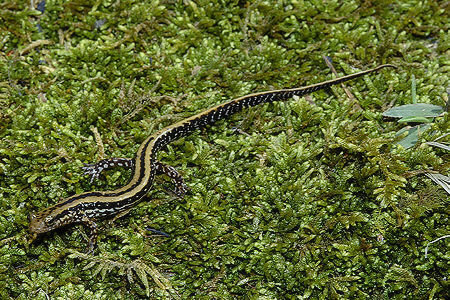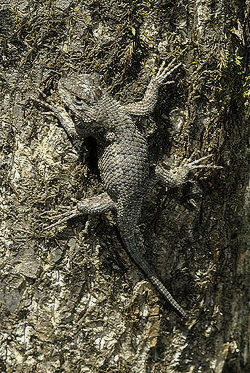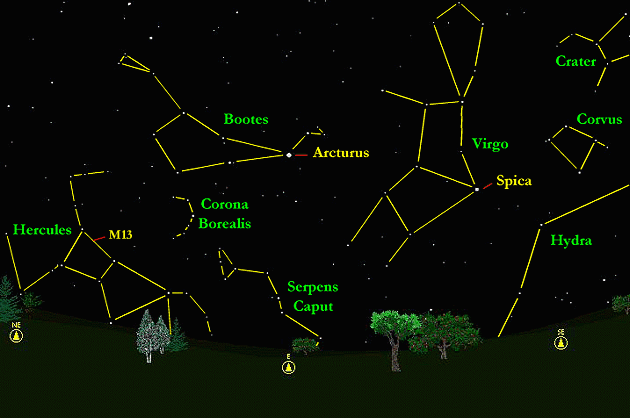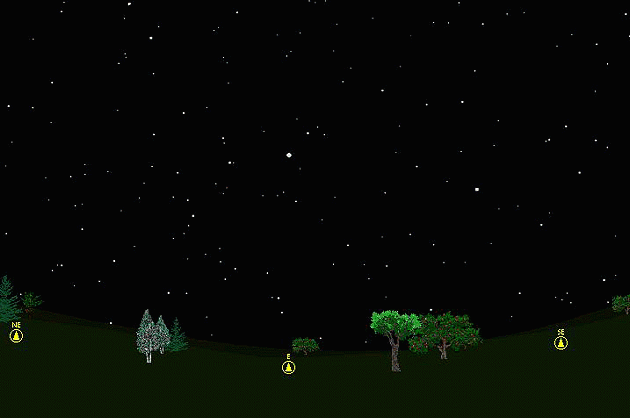The purpose of this feature is to give scout leaders, educators and naturalists an idea of some of the natural events coming up each month. We will try to cover a variety of natural events ranging from sky events to calling periods of amphibians, bird and mammal watching tips, prominent wildflowers and anything else that comes to mind. We will also note prominent constellations appearing over the eastern horizon at mid-evening each month for our area for those who would like to learn the constellations. If you have suggestions for other types of natural information you would like to see added to this calendar, let us know!. Note: You can click on the hyperlinks to learn more about some of the featured items. To return to the Calendar, hit the "back" button on your browser, NOT the "back" button on the web page. All charts are available in a "printer friendly" mode, with black stars on a white background. Left clicking on each chart will take you to a printable black and white image.
Notes and Images From March 2007
The warm weather we have been having this spring really seems to have accelerated the pace of natural events. We have heard many frog and toad species calling (see Amphibians, below) and we saw in March many warbler species we normally do not see until April. On March 14th I was very fortunate to witness a type of Red-tailed Hawk courtship display that was unknown to me. I had been watching a pair of Red-tails circle above, separated by about a half-mile. One hawk, presumably the male, suddenly dove towards the ground at a very steep angle. Just before reaching the ground it suddenly pulled up sharply and coasted up to an altitude almost equal to its former altitude. Just as it lost momentum, it tucked its wings in and again plummeted towards the ground. It repeated the maneuver three more times, losing a little altitude at the top of its arc each time.
It timed its last pull-up perfectly to coast up to a tree branch. It was a beautiful display of flying skill. We found this Three-lined Salamander while doing our natural inventories near Anniston, Alabama. Many lizards were also out and about, and we photographed the Eastern Fence Lizard shown below on the day before. We also had 11 species of warblers, a respectable total for March.
A King Rail called from one of the wetland areas. We managed to lure the rail into sight and got a beautiful view of its deep orange colors. The recording we made of the rail's call includes a wonderful assortment of wetland creatures. Arthur Cleveland Bent, in Life Histories of North American Birds, includes the following description of the King Rail's call by a Mr. Murchison (1895): "One of the very characteristic sounds of bird voices to be heard on the borders and nearby ponds of the large swamps in Henry County, Illinois, is the "chuck-chuck" of the king rail, or "stage driver," as he is called by the natives, from the almost exact imitation of the "chuck" of the plowboy to his plodding team."
Sky Events for April 2007: The Lyrid Meteor Shower peaks on April 22nd. Although this is a fairly weak shower, the conditions should be good in the early morning hours, with no moon visible to spoil the show. Evening Sky: In April, Venus continues to climb higher in the evening twilight. It appears before any star or planet. This month is a good chance to see Saturn. The ringed planet is well place for viewing all month long. At dusk, look for it in the southern sky near the "sickle" of the constellation Leo. Jupiter rises about 11:30pm at mid-month near the bright star Antares, in Scorpius. Morning Sky: Mars rises about 4:15am at midmonth in Aquarius. All times noted in the Sky Events are for Franklin, Tennessee and are Central Daylight Time. These times should be pretty close anywhere in the mid-state area.
Constellations: The views below show the sky looking east at 9:00pm CDT on April 20th. The first view shows the sky with the constellation outlined and names depicted. Star and planet names are in yellow. Constellation names are in green. The second view shows the same scene without labels. New constellations this month in the eastern sky are Serpens Caput, the Serpent (Head), and Hercules, the Strongman. As spring progresses and Hercules rises higher in the sky, look for the globular cluster Messier 13 (M13), which appears like a small fuzzy patch of light about 1/3 of the distance between Eta and Zeta Hercules (see illustration below). A cluster of stars about 21,000 light years away, M13 can be made out with the naked eye in a dark country sky when the constellation is high in the sky. Binoculars help pick it out.
On Learning the Constellations: We advise learning a few constellations each month, and then following them through the seasons. Once you associate a particular constellation coming over the eastern horizon at a certain time of year, you may start thinking about it like an old friend, looking forward to its arrival each season. The stars in the evening scene above, for instance, will always be in the same place relative to the horizon at the same time and date each April. Of course, the planets do move slowly through the constellations, but with practice you will learn to identify them from their appearance. In particular, learn the brightest stars (Like Arcturus and Spica in the above scene looking east), for they will guide you to the fainter stars. Once you can locate the more prominent constellations, you can "branch out" to other constellations around them. It may take you a little while to get a sense of scale, to translate what you see on the computer screen or what you see on the page of a book to what you see in the sky. Look for patterns, like the stars that make up the constellation Corvus. The earth's rotation causes the constellations to appear to move across the sky just as the sun and the moon appear to do. If you go outside earlier than the time shown on the charts, the constellations will be lower to the eastern horizon. If you observe later, they will have climbed higher. As each season progresses, the earth's motion around the sun causes the constellations to appear a little farther towards the west each night for any given time of night. If you want to see where the constellations in the above figures will be on May 20th at 9:00pm CDT, you can stay up till 11:00pm CDT on the April 20th and get a preview. The westward motion of the constellations is equivalent to two hours per month. A good book to learn the constellations is H. A. Rey's classic, The Stars, A New Way to See Them. Rey's depictions of the constellations and witty commentary are terrific. A good general reference book on astronomy is the Peterson Field Guide, A Field Guide to the Stars and Planets, by Pasachoff. The book retails for around $14.00. A good beginners software program for learning the night sky is the Starry Night Beginner program. Visit the Starry Night web site at www.starrynight.com The program retails for around $30.00 and contains a wealth of information.
Amphibians:
This has been a very warm spring, and we've already heard American Toads, Fowler's Toads, Northern Cricket Frogs, Southern Cricket Frogs, Southeastern Chorus Frogs, Spring Peepers, Cope's Gray Treefrogs, Green Treefrogs, Southern Leopard Frogs, American Bullfrogs, and Green Frogs. The early calls of Gray Treefrogs sound raspier than the normal trill, as if the frog needs to clear its throat.
Birds: The spring migration builds very quickly in April. The neo-tropical migrants are too numerous to list here, but now is the time to get out in the early morning with a pair of binoculars and welcome the new arrivals for the day. Listen at dusk for young Great Horned Owls and Young Barred Owls, doing their raspy "begging" calls. Recommended: Bird Finding in Tennessee, Michael Lee Bierly. A classic guide to finding birds in Tennessee. The Sibley Guide to Birds, David Allen Sibley The Sibley Guide to Birds of Eastern North America, David Allen Sibley An inexpensive guide for beginners is the Golden Guide for Birds.
Wildflowers: Some of our favorite Spring wildflower walks are: The south ridge at the Owl's Hill Nature Center in Brentwood, Tennessee. The Edwin Warner paved loop at the Warner Parks in Nashville or just about any trail in Warner Parks. The Angel Falls trail along the Cumberland River at the Big South Fork Recreational Area, near Jamestown, Tennessee.
Archives (Remember to use the back button on your browser, NOT the back button on the web page!) Natural Calendar February 2007 Natural Calendar December 2006 Natural Calendar November 2006 Natural Calendar September 2006 Natural Calendar February 2006
Natural Calendar
December 2005
Natural Calendar
November 2005
Natural Calendar
September 2005
Natural Calendar
February 2005
Natural Calendar
December 2004
Natural Calendar
November 2004
Natural Calendar
September 2004
Natural Calendar
February 2004
Natural Calendar
December 2003
Natural Calendar
November 2003
Natural Calendar
September 2003 Natural Calendar February 2003 Natural Calendar December 2002 Natural Calendar November 2002 Nature Notes Archives: Nature Notes was a page we published in 2001 and 2002 containing our observations about everything from the northern lights display of November 2001 to frog and salamander egg masses. Night scenes prepared with Starry Night Pro software All images and recordings © 2007 Leaps
|
